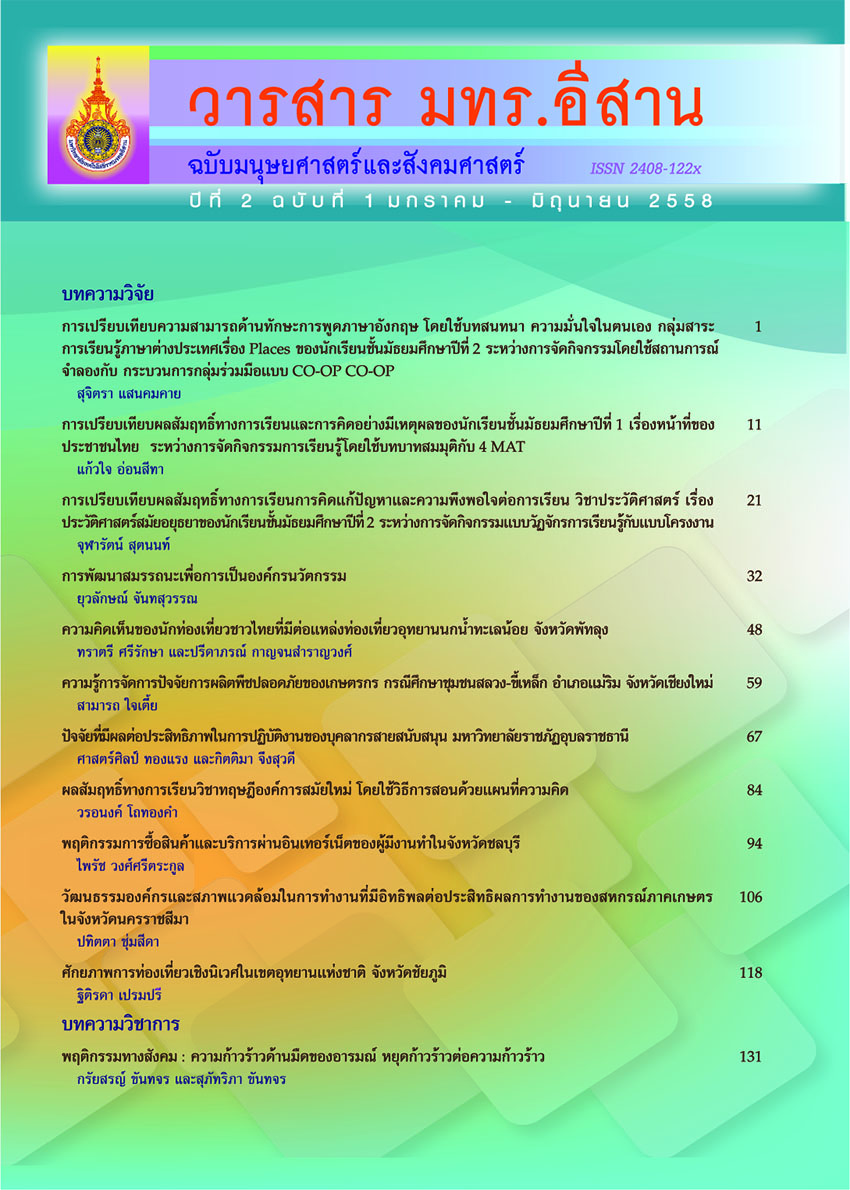Development of Modern Organization Theory Learning Achievement by Using the Mind Map
Main Article Content
Abstract
The purpose of this research was (1) to compare the study’s achievement of the students in modern organization theory subject using normal teaching methods and mind-mapping methods (2) to study the attitudes of students toward learning modern organization theory by mind-mapping approach. The samples of this research consist of undergraduate students in Business Administration Faculty, Rajamangala University of Technology Isan, Nakhon Ratchasima. These students are enrolled in Modern Management Theory class in the first semester of the 2556 academic year. Proportional Stratified random sampling was applied. The data were collected among students in one section of general management students and two sections of Industrial management students. The number of samples includes 40 students. The instruments used in this study are 10 chapters of mind-mapping type, 4 rating-scale questionnaires and 5 rating-scale questionnaires. Data were analyzed by frequency, percentage, mean, standard deviation, and t-tests of the two dependent groups (t-test for Dependent Samples).
The results showed that: (1) student’s learning achievement of modern organization theory subject using the concept mind-mapping method has higher pretest scores than that normal teaching methods by 2.08 points (out of an average of 10 points). The concept mind-mapping method mean score was significantly higher than the mean score of normal teaching methods at the 0.01 significance level (2) students’ attitude toward learning of Modern Organization theory is in a high level. Regarding learning process on how to teach using concept maps, students’ agreements on the application of mind-mapping is in the highest level. Finally, students’ opinions on the following factors are in the high level: social interaction with the instructor using a mind map followed by the application of knowledge on how to teach using concept maps, the creation of knowledge and how to teach using concept maps, and physical involvement with teaching methods using concept maps respectively.
Article Details
บทความที่ได้รับการตีพิมพ์เป็นลิขสิทธิ์ของมหาวิทยาลัยเทคโนโลยีราชมงคลอีสาน
ข้อความที่ปรากฏในบทความแต่ละเรื่องในวารสารวิชาการเล่มนี้เป็นความคิดเห็นส่วนตัวของผู้เขียนแต่ละท่านไม่เกี่ยวข้องกับมหาวิทยาลัยเทคโนโลยีราชมงคลอีสานและคณาจารย์ท่านอื่นๆในมหาวิทยาลัยฯ แต่อย่างใด ความรับผิดชอบองค์ประกอบทั้งหมดของบทความแต่ละเรื่องเป็นของผู้เขียนแต่ละท่าน หากมีความผิดพลาดใดๆ ผู้เขียนแต่ละท่านจะรับผิดชอบบทความของตนเองแต่ผู้เดียว
References
นิตยา อัจฉริยานุกูล. (2550). การพัฒนารูปแบบการสอนโดยใช้แผนที่ความคิดในกลุ่มสาระการเรียนรู้ภาษาไทยสำหรับนักเรียนช่วงชั้นที่ 1 ชั้นประถมศึกษาปีที่ 2. วิทยานิพนธ์ปริญญาครุศาสตรมหาบัณฑิตสาขาวิชาหลักสูตรและการสอน มหาวิทยาลัยราชภัฏจันทรเกษม
บุญใจ ศรีสถิตย์นรากูร. (2550). ระเบียบวิธีการวิจัย : แนวทางปฏิบัติสู่ความสำเร็จ. จุฬาลงกรณ์มหาวิทยาลัย
อลภา ทองไชย. (2555). การพัฒนาผลสัมฤทธิ์ทางการเรียน เรื่อง การสังเคราะห์ด้วยแสงโดยใช้แผนที่ความคิดของนักศึกษาหลักสูตรชีววิทยา ขั้นปีที่ 1 ปีการศึกษา 2555. รายงานวิจัยชั้นเรียนภาควิชาวิทยาศาสตร์ มหาวิทยาลัยราชภัฏยะลา
Buzan T. & Buzan B. (1997). The Mind Map Book : Radiant Thinking. London : BBC Book


